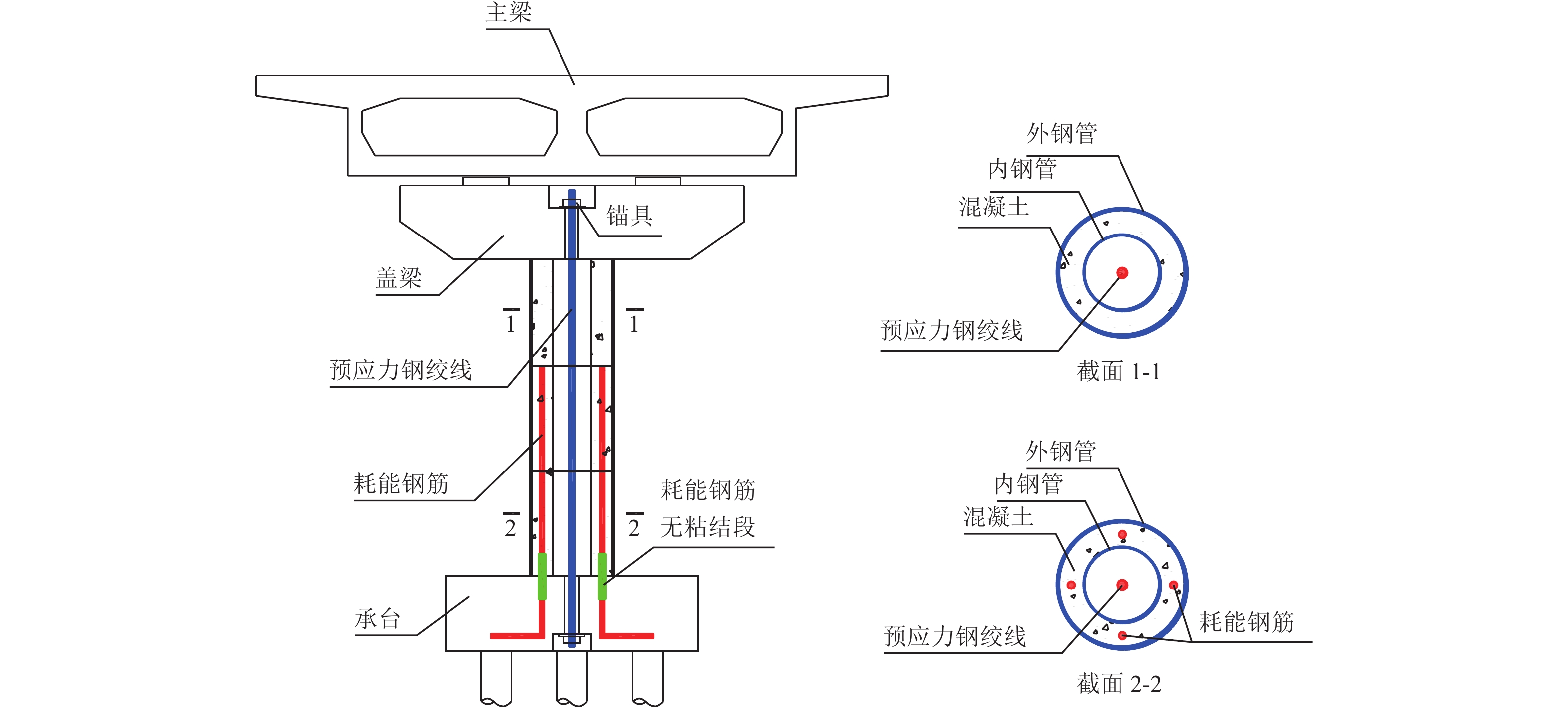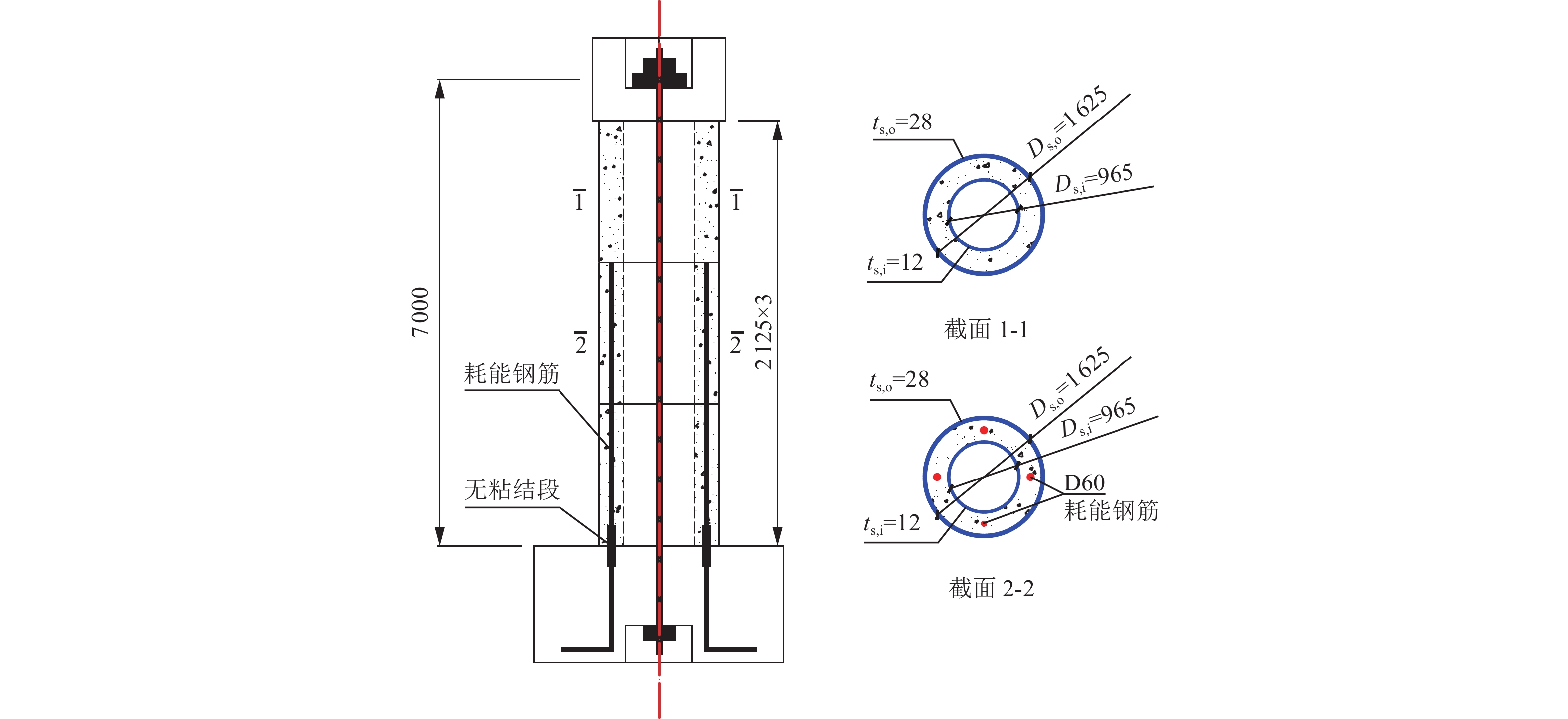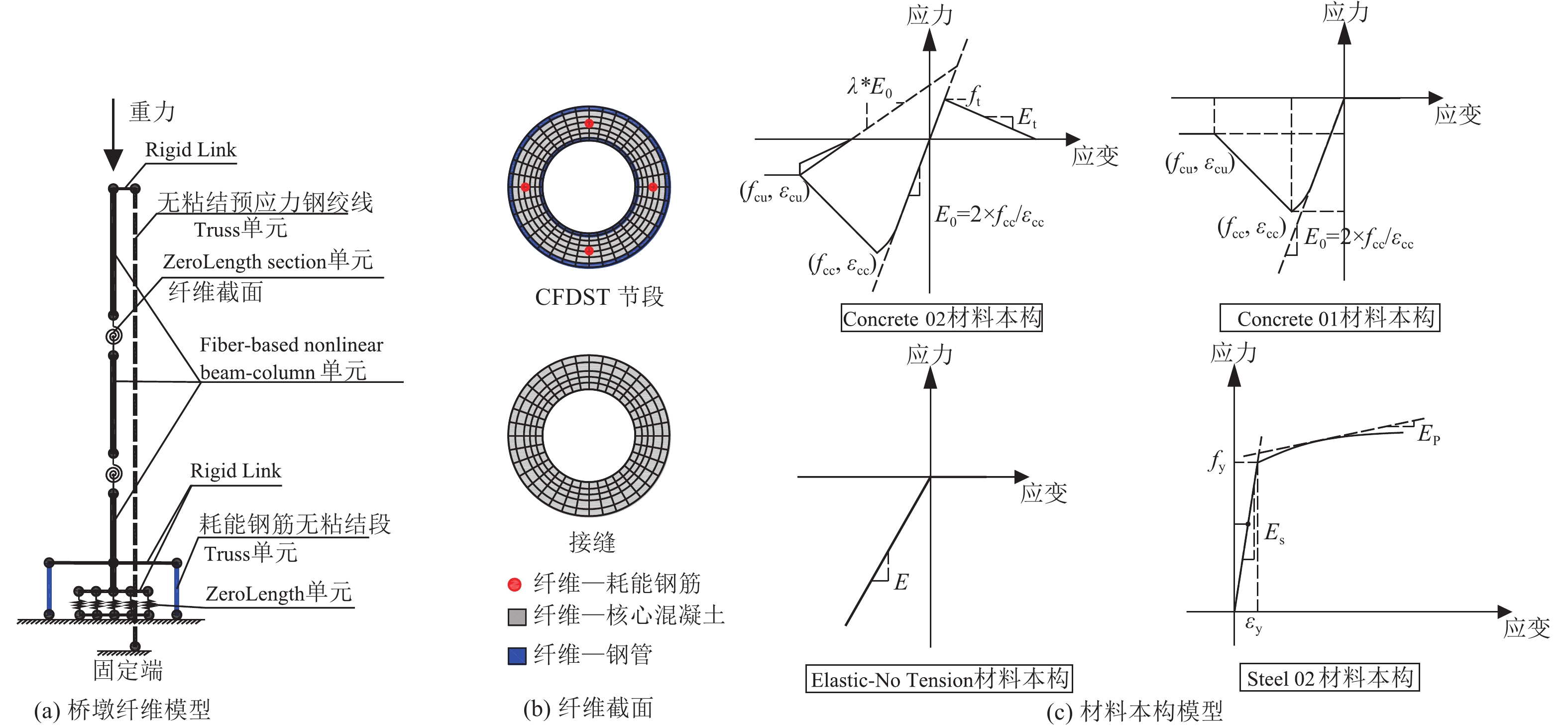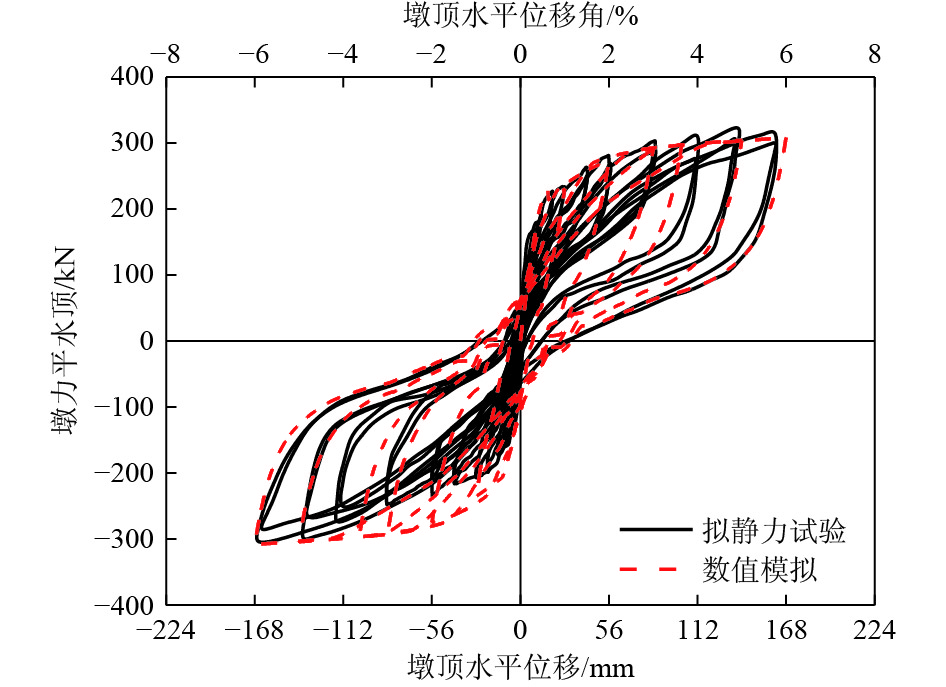Seismic Fragility Analysis of Self-centering Precast Segmental Concrete-filled Double Skin Steel Tubular Piers
-
摘要: 为评估自复位预制节段拼装中空夹层钢管混凝土(Concrete-filled Double Skin Steel Tubular, CFDST)桥墩在地震动作用下的易损性,本研究基于现有的低周反复荷载试验数据,采用有限元分析方法,选用墩顶水平位移角和残余位移角2个指标作为评估标准进行定量分析。针对3种不同类型地震动(远场、近场无脉冲和近场有脉冲),分别建立了关于水平位移角和残余位移角2个指标的易损性曲线,并分析了不同损伤指标和地震动类型对其地震易损性的影响。研究结果表明,在自复位预制节段拼装CFDST桥墩地震易损性分析中,仅采用水平位移角作为损伤指标是安全可靠的;相比远场地震动和近场无脉冲型地震动而言,近场脉冲型地震动对自复位预制节段拼装CFDST桥墩的变形和自复位有显著影响。Abstract: This paper evaluates the seismic vulnerability of self-centering precast segmental concrete-filled double skin steel tubular (CFDST) piers by quantitatively assessing their seismic performance under three types of ground motions: far-field, near-field without pulse, and near-field pulse-like motions, based on existing quasi-static tests. Using finite element analysis, vulnerability curves for the self-centering precast segmental CFDST piers are established based on two damage indices: the horizontal displacement angle and the residual displacement angle. The study analyzes the effects of different damage indices and ground motion types on the vulnerability curves of the self-centering precast segmental CFDST piers. The results indicate that utilizing only the horizontal displacement angle as the damage index is both safe and reliable for the seismic vulnerability analysis of these piers. Additionally, it was found that near-field pulse-like ground motions significantly affect the deformation and self-centering behavior of the self-centering precast segmental CFDST piers compared to far-field and near-field non-pulse-like ground motions.
-
图 4 滞回曲线(Li等,2023b)
Figure 4. Hysteretic curve of self-centering precast segmental assembled CFDST piers (Li et al., 2023b)
表 1 关键性能指标
Table 1. Critical performance indexes
屈服位移/mm 屈服荷载/kN 峰值荷载/kN 弹性刚度/(kN·mm−1) 峰值残余位移/mm 试验 17.8 208 319 11.7 30.0 模拟 18.0 216 308 12.0 31.8 相对误差 1.1% 3.8% 3.4% 2.6% 6.0% 表 2 远场地震动记录
Table 2. Far-field ground motion records
编号 地震名称 年份 站台名称 震级/级 Rrup/km T90%/s 1 "Northwest Calif-01" 1938 "Ferndale City Hall" 5.5 53.58 11.6 2 "Northwest Calif-02" 1941 "Ferndale City Hall" 6.6 91.22 22.2 3 "Northern Calif-01" 1941 "Ferndale City Hall" 6.4 44.68 15.5 4 "Borrego" 1942 "El Centro Array #9" 6.5 56.88 37.2 5 "Northwest Calif-03" 1951 "Ferndale City Hall" 5.8 53.77 15.4 6 "Kern County" 1952 "LA - Hollywood Stor FF" 7.36 117.75 33.5 7 "Kern County" 1952 "Pasadena - CIT Athenaeum" 7.36 125.59 29.5 8 "Kern County" 1952 "Santa Barbara Courthouse" 7.36 82.19 33.6 9 "Kern County" 1952 "Taft Lincoln School" 7.36 38.89 30.3 10 "Northern Calif-02" 1952 "Ferndale City Hall" 5.2 43.28 18.4 11 "Northern Calif-03" 1954 "Ferndale City Hall" 6.5 27.02 19.4 12 "El Alamo" 1956 "El Centro Array #9" 6.8 121.7 40.9 13 "Northern Calif-04" 1960 "Ferndale City Hall" 5.7 57.21 28.4 14 "Northern Calif-05" 1967 "Ferndale City Hall" 5.6 28.73 22.1 15 "Borrego Mtn" 1968 "El Centro Array #9" 6.63 45.66 49.3 16 "Borrego Mtn" 1968 "San Onofre - So Cal Edison" 6.63 129.11 28 17 "San Fernando" 1971 " 2516 Via Tejon PV"6.61 55.2 54.2 18 "San Fernando" 1971 "Carbon Canyon Dam" 6.61 61.79 18.9 19 "San Fernando" 1971 "Castaic-Old Ridge Route" 6.61 22.63 16.8 20 "San Fernando" 1971 "Fairmont Dam" 6.61 30.19 14.4 表 3 近场无脉冲型地震动
Table 3. Near-field non-pulse-like ground motion
编号 地震名称 年份 站台名称 震级/级 Rrup /km T90%/s 1 "Imperial Valley-02" 1935 "El Centro Array #9" 6.95 6.09 24.2 2 "Hollister-02" 1961 "Hollister City Hall" 5.5 18.08 16.5 3 "Parkfield" 1966 "Cholame - Shandon Array #12" 6.19 17.64 29 4 "Parkfield" 1966 "Cholame - Shandon Array #5" 6.19 9.58 7.5 5 "Parkfield" 1966 "Cholame - Shandon Array #8" 6.19 12.9 13.1 6 "Managua_Nicaragua-01" 1972 "Managua_ ESSO" 5.24 4.06 10.6 7 "Hollister-03" 1974 "Hollister City Hall" 5.17 9.39 10.9 8 "Coyote Lake" 1979 "Coyote Lake Dam - Southwest Abutment" 5.74 6.13 8.5 9 "Imperial Valley-06" 1979 "Calexico Fire Station" 6.53 10.45 14.8 10 "Imperial Valley-06" 1979 "Cerro Prieto" 6.53 15.19 36.4 11 "Imperial Valley-06" 1979 "Chihuahua" 6.53 7.29 24 12 "Imperial Valley-06" 1979 "Parachute Test Site" 6.53 12.69 18.6 13 "Imperial Valley-07" 1979 "El Centro Array #5" 5.01 11.23 7 14 "Imperial Valley-07" 1979 "El Centro Array #6" 5.01 10.37 6.5 15 "Mammoth Lakes-02" 1980 "Mammoth Lakes H. S." 5.69 9.12 3.9 16 "Mammoth Lakes-03" 1980 "Convict Creek" 5.91 12.43 6.3 17 "Mammoth Lakes-03" 1980 "Long Valley Dam (Downst)" 5.91 18.13 12.4 18 "Mammoth Lakes-03" 1980 "Long Valley Dam (Upr L Abut)" 5.91 18.13 8.4 19 "Mammoth Lakes-06 1980 "Fish & Game (FIS)" 5.94 12.93 5.1 20 "Westmorland" 1981 "Salton Sea Wildlife Refuge" 5.9 7.83 9.1 表 4 近场脉冲型地震动
Table 4. Near-field pulse-like ground motion records
编号 地震名称 年份 站台名称 震级/级 Rrup/km T90%/s 1 "Coyote Lake" 1979 "Gilroy Array #2" 5.74 9.02 7.5 2 "Coyote Lake" 1979 "Gilroy Array #3" 5.74 7.42 8.7 3 "Coyote Lake" 1979 "Gilroy Array #4" 5.74 5.7 11 4 "Imperial Valley-06" 1979 "Agrarias" 6.53 0.65 13.3 5 "Imperial Valley-06" 1979 "Brawley Airport" 6.53 10.42 14.9 6 "Imperial Valley-06" 1979 "EC County Center FF" 6.53 7.31 13.2 7 "Imperial Valley-06" 1979 "El Centro Array #10" 6.53 8.6 12.8 8 "Imperial Valley-06" 1979 "El Centro Array #3" 6.53 12.85 14.1 9 "Imperial Valley-06" 1979 "Holtville Post Office" 6.53 7.5 12.8 10 "Irpinia_ Italy-01" 1980 "Bagnoli Irpinio" 6.9 8.18 19.6 11 "Irpinia_ Italy-01" 1980 "Sturno (STN)" 6.9 10.84 15.2 12 "Westmorland" 1981 "Parachute Test Site" 5.9 16.66 18.7 13 "Morgan Hill" 1984 "Gilroy Array #6" 6.19 9.87 7.3 14 "Kalamata_ Greece-02" 1986 "Kalamata (bsmt) (2 nd trigger)" 5.4 5.6 2.9 15 "Superstition Hills-02" 1987 "Kornbloom Road (temp)" 6.54 18.48 13.9 16 "Loma Prieta" 1989 "Gilroy - Historic Bldg." 6.93 10.97 13.1 17 "Loma Prieta" 1989 "Saratoga - W Valley Coll." 6.93 9.31 11.1 18 "Kocaeli_ Turkey" 1999 "Arcelik" 7.51 13.49 11.1 19 "Kocaeli_ Turkey" 1999 "Gebze" 7.51 10.92 8.2 20 "Coyote Lake" 1979 "Gilroy Array #2" 5.74 9.02 7.5 表 5 自复位预制节段拼装CFDST桥墩抗震性能水准指标取值范围
Table 5. Range of performance level indexes of self-centering precast segmental CFDST pier
性能等级 性能水准 耗能钢筋拉应变ε 钢绞线拉应变εp θdr θR Ⅰ 基本完好 $ < {\varepsilon _{\text{y}}}$ / <1.00 % / Ⅱ 轻微损伤 $ < {\varepsilon _{{\text{sh}}}} = 0.015$ / <2.25% <0.50% Ⅲ 可恢复损伤/生命安全 $ < 0.6{\varepsilon _{{\text{su}}}} = 0.06$ / <5.50% <1.00% Ⅳ 严重损伤/防止倒塌 $ < {\varepsilon _{{\text{su}}}} = 0.10$ $ < {\varepsilon _{{\text{py}}}} = 0.0086$ <8.50% <1.75% Ⅴ 局部失效/倒塌 $ > {\varepsilon _{{\text{su}}}} = 0.10$ $ > {\varepsilon _{{\text{py}}}} = 0.0086$ >8.50% >1.75% 表 6 桥墩概率地震需求模型
Table 6. Probabilistic earthquake demand model of pier
性能指标 近场无脉冲地震 近场脉冲地震动 远场地震动 墩顶最大水平位移角 ln(θdr) = 1.1468 ln(PGA)−3.8139 ln(θdr) = 1.21112 ln(PGA) −2.3137 ln(θdr) = 0.8328 ln(PGA) −2.8025 墩顶残余位移角 ln(θR) = 1.7973 ln(PGA) −4.8048 ln(θR) = 1.8553 ln(PGA) −4.9436 ln(θR) = 1.4748 ln(PGA) −5.9554 -
董慧慧,李辉,杜修力,2023. 近场脉冲型地震动横向激励下附加SCEB双柱式桥墩结构易损性分析. 北京工业大学学报,49(5):532−546. doi: 10.11936/bjutxb2021110002Dong H. H., Li H., Du X. L., 2023. Fragility analysis of the double-column bent with the SCEB under near-field pulse-like ground motions in transverse direction. Journal of Beijing University of Technology, 49(5): 532−546. (in Chinese) doi: 10.11936/bjutxb2021110002 葛继平,王志强,2011. 干接缝节段拼装桥墩振动台试验研究. 工程力学,28(9):122−128.Ge J. P., Wang Z. Q., 2011. Shake table tests of segmental bridge columns with match-cast dry joints. Engineering Mechanics, 28(9): 122−128. (in Chinese) 何益斌,李毅,郭健等,2012. 中空夹层钢管混凝土柱与钢-混凝土组合梁节点抗震性能试验研究. 建筑结构学报,33(7):106−115.He Y. B., Li Y., Guo J., et al., 2012. Experimental study on seismic behavior of concrete-filled double skin steel tubular column and steel-concrete beam composite joints. Journal of Building Structures, 33(7): 106−115. (in Chinese) 胡晓斌,贺慧高,2015. 强震下单自由度体系残余位移离散性研究. 地震工程与工程振动,35(6):213−218.Hu X. B., He H. G., 2015. Study on the dispersion of residual displacement of SDOF system under strong earthquake. Earthquake Engineering and Engineering Dynamics, 35(6): 213−218. (in Chinese) 胡志坚,闫明辉,周知等,2022. 预制拼装桥墩地震易损性分析. 土木工程学报,55(1):89−99,108.Hu Z. J., Yan M. H., Zhou Z., et al., 2022. Seismic vulnerability analysis of precast segmental bridge piers. China Civil Engineering Journal, 55(1): 89−99,108. (in Chinese) 贾晗曦,林均岐,刘金龙,2019. 建筑结构地震易损性分析研究综述. 震灾防御技术,14(1):42−51. doi: 10.11899/zzfy20190105Jia H. X., Lin J. Q., Liu J. L., 2019. Review of seismic fragility analysis of building structure. Technology for Earthquake Disaster Prevention, 14(1): 42−51. (in Chinese) doi: 10.11899/zzfy20190105 贾俊峰,赵建瑜,张强等,2017. 后张预应力节段拼装CFST桥墩抗侧力学行为试验. 中国公路学报,30(3):236−245. doi: 10.3969/j.issn.1001-7372.2017.03.026Jia J. F., Zhao J. Y., Zhang Q., et al., 2017. Experiment on lateral bearing behavior of post-tensioned segmental CFST bridge pier columns. China Journal of Highway and Transport, 30(3): 236−245. (in Chinese) doi: 10.3969/j.issn.1001-7372.2017.03.026 蒋欢军,王斌,吕西林,2010. 钢筋混凝土梁和柱性能界限状态及其变形限值. 建筑结构,40(1):10−14.Jiang H. J., Wang B., Lü X. L., 2010. Performance limit states and deformation limits of RC beams and columns. Building Structure, 40(1): 10−14. (in Chinese) 李宁,张双城,李忠献等,2020. 预制拼装钢管混凝土自复位桥墩变形分析模型及验证. 工程力学,37(4):135−143.Li N., Zhang S. C., Li Z. X., et al., 2020. Deformation analysis model and validation for precast segmental concrete filed steel tube self-centering bridge column. Engineering Mechanics, 37(4): 135−143. (in Chinese) 林上顺,厉良勇,叶世集等,2024. 采用混合连接装配式桥墩地震易损性分析. 地震工程学报,46(2):251−258,268.Lin S. S., Li L. Y., Ye S. J., et al., 2024. Seismic vulnerability analysis of assembled piers with a hybrid connection. China Earthquake Engineering Journal, 46(2): 251−258,268. (in Chinese) 刘黎明,徐超,卜春尧等,2021. 双向水平地震动作用对某钢筋混凝土连续梁桥易损性的影响. 震灾防御技术,16(4):671−679. doi: 10.11899/j.issn.1673-5722.2021.4.zzfyjs202104008Liu L. M., Xu C., Bu C. Y., et al., 2021. Influence of Bi-directional horizontal ground motion on the vulnerability of a reinforced concrete continuous beam bridge. Technology for Earthquake Disaster Prevention, 16(4): 671−679. (in Chinese) doi: 10.11899/j.issn.1673-5722.2021.4.zzfyjs202104008 刘艳辉,赵世春,强士中,2010. 城市高架桥抗震性能水准的量化. 西南交通大学学报,45(1):54−58,64. doi: 10.3969/j.issn.0258-2724.2010.01.009Liu Y. H., Zhao S. C., Qiang S. Z., 2010. Quantification of seismic performance levels for urban viaduct. Journal of Southwest Jiaotong University, 45(1): 54−58,64. (in Chinese) doi: 10.3969/j.issn.0258-2724.2010.01.009 罗征,李建中,2013. 低周往复荷载下空心矩形墩抗震性能试验研究. 振动与冲击,32(8):183−188.Luo Z., Li J. Z., 2013. Tests for a seismic performance of rectangular hollow thin-walled bridge columns under low-cycle reversed loading. Journal of Vibration and Shock, 32(8): 183−188. (in Chinese) 漆启明,邵长江,胡晨旭等,2020. 空心墩地震损伤评估及性能水准量化研究. 土木工程学报,53(11):116−128.Qi Q. M., Shao C. J., Hu C. X., et al., 2020. Study on seismic damage assessment and performance level quantification of hollow pier. China Civil Engineering Journal, 53(11): 116−128. (in Chinese) 任文静,邱大鹏,张智等,2024. 考虑构件地震相关性的近海桥梁二维地震易损性分析. 震灾防御技术,19(1):96−107. doi: 10.11899/zzfy20240110Ren W. J., Qiu D. P., Zhang Z., et al., 2024. The two-dimensional seismic fragility analysis of the offshore bridge in considering the seismic correlation between different components. Technology for Earthquake Disaster Prevention, 19(1): 96−107. (in Chinese) doi: 10.11899/zzfy20240110 石岩,张智超,李军等,2022. 考虑内力状态的大跨高墩连续刚构桥地震易损性分析. 地震研究,45(1):8−16.Shi Y., Zhang Z. C., Li J., et al., 2022. Seismic fragility of the long-span, continuous, rigid-frame bridge with high-rise pier involving the state of the internal force. Journal of Seismological Research, 45(1): 8−16. (in Chinese) 司炳君,谷明洋,孙治国等,2017. 近断层地震动下摇摆-自复位桥墩地震反应分析. 工程力学,34(10):87−97. doi: 10.6052/j.issn.1000-4750.2016.05.0386Si B. J., Gu M. Y., Sun Z. G., et al., 2017. Seismic response analysis of the rocking self-centering bridge piers under the near-fault ground motions. Engineering Mechanics, 34(10): 87−97. (in Chinese) doi: 10.6052/j.issn.1000-4750.2016.05.0386 孙治国,赵泰儀,石岩等. 2019. 摇摆-自复位桥墩抗震性能数值建模方法研究. 应用基础与工程科学学报, 27 (6):1357−1369.Sun Z. G., Zhao T. Y., Shi Y., et al., 2019. Research on numerical modeling method for rocking self-centering bridge piers. Journal of Basic Science and Engineering, 27 (6): 1357−1369. (in Chinese) 王军文,李海洋,闫聚考等,2018. 地震作用下钢筋混凝土桥墩残余位移研究. 振动与冲击,37(13):130−134.Wang J. W., Li H. Y., Yan J. K., et al., 2018. Residual displacements of RC piers under action of earthquake. Journal of Vibration and Shock, 37(13): 130−134. (in Chinese) 王震,2018. 自复位预制拼装UHPC空心墩抗震性能及设计方法研究. 南京:东南大学.Wang Z., 2018. Research on seismic performance and design method of self-centering precast segmental UHPC hollow bridge piers. Nanjing:Southeast University. (in Chinese) 魏标,2010. 典型非规则梁桥抗震设计理论. 上海:同济大学.Wei B., 2010. Seismic design theory of typical irregular continuous bridges. Shanghai:Tongji University. (in Chinese) 许成祥,罗恒,王粘锦,2022. 双层高架桥框架式桥墩地震易损性分析. 重庆交通大学学报(自然科学版),41(8):95−101. doi: 10.3969/j.issn.1674-0696.2022.08.14Xu C. X., Luo H., Wang Z. J., 2022. Seismic fragility analysis of double-deck Viaducts’ Frame piers. Journal of Chongqing Jiaotong University (Natural Science), 41(8): 95−101. (in Chinese) doi: 10.3969/j.issn.1674-0696.2022.08.14 曾武华,卓卫东,王东升,2021. RC桥墩残余位移指标影响因素分析及贝叶斯估计. 振动与冲击,40(19):145−150.Zeng W. H., Zhuo W. D., Wang D. S., 2021. Influence factors analysis and Bayesian estimation for residual displacement index of RC pier. Journal of Vibration and Shock, 40(19): 145−150. (in Chinese) 张勤,贡金鑫,周继凯,2017. 基于概率的单自由度体系震后残余变形计算. 建筑结构学报,38(8):74−82.Zhang Q., Gong J. X., Zhou J. K., 2017. Seismic residual deformation analysis of single degree of freedom system based on probability. Journal of Building Structures, 38(8): 74−82. (in Chinese) 张云,谭平,郑建勋等,2014. 基于性能的中小跨径装配式梁桥地震易损性分析. 振动工程学报,27(5):676−684. doi: 10.3969/j.issn.1004-4523.2014.05.005Zhang Y., Tan P., Zheng J. X., et al., 2014. Fragility analysis for performance-based seismic design of prefabricated bridge with middle-small span. Journal of Vibration Engineering, 27(5): 676−684. (in Chinese) doi: 10.3969/j.issn.1004-4523.2014.05.005 赵建锋,孙伟帅,李刚,2018. 不同轴压比钢筋混凝土圆柱桥墩地震易损性分析. 世界地震工程,34(4):31−37.Zhao J. F., Sun W. S., Li G., 2018. Seismic vulnerability analysis of cylindrical RC bridge piers with different axial compression ratios. World Earthquake Engineering, 34(4): 31−37. (in Chinese) 周雨龙,韩强,张劲泉等,2021. 消能自复位摇摆框架墩结构地震反应及易损性分析. 中国公路学报,34(11):153−164. doi: 10.3969/j.issn.1001-7372.2021.11.013Zhou Y. L., Han Q., Zhang J. Q., et al., 2021. Seismic response and fragility analysis of post-tensioned rocking bridge frames with dampers. China Journal of Highway and Transport, 34(11): 153−164. (in Chinese) doi: 10.3969/j.issn.1001-7372.2021.11.013 Ahmadi E., Kocakaplan S., Kashani M. M., 2022. Nonlinear seismic fragility analysis of a resilient precast post-tensioned segmental bridge pier. Sustainable and Resilient Infrastructure, 7(6): 823−841. doi: 10.1080/23789689.2022.2082644 Christopoulos C., Pampanin S., Priestley M. J. N., 2003. Performance-based seismic response of frame structures including residual deformations. Part I: single-degree of freedom systems. Journal of Earthquake Engineering, 7(1): 97−118. Dawood H., Elgawady M., Hewes J., 2014. Factors affecting the seismic behavior of segmental precast bridge columns. Frontiers of Structural and Civil Engineering, 8(4): 388−398. doi: 10.1007/s11709-014-0264-8 Filippou F. C., Popov E. P., Bertero V. V., 1983. Effects of bond deterioration on hysteretic behavior of reinforced concrete joints. Berkeley: Earthquake Engineering Research Center, University of California. Hewes J. T., Priestley M. J. N., 2002. Seismic design and performance of precast concrete segmental bridge columns. San Diego: University of California. Hose Y., Silva P., Seible F., 2000. Development of a performance evaluation database for concrete bridge components and systems under simulated seismic loads. Earthquake Spectra, 16(2): 413−442. doi: 10.1193/1.1586119 Japan Road Association, 2002. Design specifications for highway bridges: part v: seismic design. Japan: Maruzen Publishing Co, Ltd. Kawashima K., MacRae G. A., Hoshikuma J. I., et al., 1998. Residual displacement response spectrum. Journal of Structural Engineering, 124(5): 523−530. doi: 10.1061/(ASCE)0733-9445(1998)124:5(523) Kent D. C., Park R., 1971. Flexural members with confined concrete. Journal of the Structural Division, 97(7): 1969−1990. doi: 10.1061/JSDEAG.0002957 Kowalsky M. J., 2000. Deformation limit states for circular reinforced concrete bridge columns. Journal of Structural Engineering, 126(8): 869−878. doi: 10.1061/(ASCE)0733-9445(2000)126:8(869) Li Y. X., Li J. Z., Shen Y., 2021. Quasi-static and nonlinear time-history analyses of post-tensioned bridge rocking piers with internal ED bars. Structures, 32: 1455−1468. doi: 10.1016/j.istruc.2021.03.099 Li Z. X., Du C. Y., Liang X., et al., 2023a. Experimental and numerical investigation on hysteretic behavior of posttensioned precast segmental Concrete-filled double skin steel tubular piers. Structures, 54: 1772−1787. doi: 10.1016/j.istruc.2023.05.128 Li Z. X., Du C. Y., Liu D., et al., 2023b. Comparative study on seismic performance of concrete-filled double skin tubular piers and hollow concrete piers: experimental and analytical. Structures, 49: 1078−1092. doi: 10.1016/j.istruc.2022.11.116 Luco N., Cornell C. A., 2000. Effects of connection fractures on SMRF seismic drift demands. Journal of Structural Engineering, 126(1): 127−136. doi: 10.1061/(ASCE)0733-9445(2000)126:1(127) Mander J. B., Priestley M. J. N., Park R., 1988. Theoretical stress-strain model for confined concrete. Journal of Structural Engineering, 114(8): 1804−1826. doi: 10.1061/(ASCE)0733-9445(1988)114:8(1804) Mander J. B., Cheng C. T., 1997. Seismic resistance of bridge piers based on damage avoidance design. Buffalo: National Center for Earthquake Engineering Research, State University of New York. Mazzoni S., McKenna F., Scott M. H., et al., 2009. Open system for earthquake engineering simulation user command-language manual. version 2.0. Berkeley: Pacific Earthquake Engineering Research Center, University of California. Menegotto M., 1973. Method of analysis for cyclically loaded R. C. plane frames including changes in geometry and non-elastic behavior of elements under combined normal force and bending. In: Proceedings of the IABSE Symposium on Resistance and Ultimate Deformablility of Structures Acted on by Well-Difined Repeated. 15−22. Muntasir Billah A. H. M., Shahria Alam M., 2015a. Seismic fragility assessment of highway bridges: a state-of-the-art review. Structure and Infrastructure Engineering, 11(6): 804−832. doi: 10.1080/15732479.2014.912243 Muntasir Billah A. H. M., Shahria Alam M., 2015b. Seismic fragility assessment of concrete bridge pier reinforced with superelastic shape memory alloy. Earthquake Spectra, 31(3): 1515−1541. doi: 10.1193/112512EQS337M Ou Y. C., Wang P. H., Tsai M. S., et al., 2010. Large-scale experimental study of Precast segmental unbonded posttensioned concrete bridge columns for seismic regions. Journal of Structural Engineering, 136(3): 255−264. doi: 10.1061/(ASCE)ST.1943-541X.0000110 Zhang Y. Y., Li Y. H., Fan W., et al., 2022. Seismic damage and assessment model analysis of prestressed segmental bridge columns. Structures, 38: 797−807. doi: 10.1016/j.istruc.2022.02.018 -




 下载:
下载:













